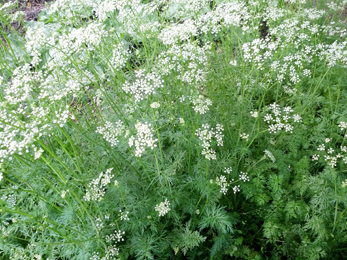Jeeraka, Cumin (Cuminum cyminum)
Description of Plant

Cumin (Cuminum cyminum) is a small annual herb which grows up to 30-50 cm in height. Its leaves are alternate, compound, filiform segment, with sheeting bases. The flowers are small white, found in compound umbels or umbrella-like clusters. The flowers have both male and female structures together and an inferior ovary that develops into a very characteristic fruit called a cremocarp. Fruits are greenish, turns grey when ripe, tapering towards both ends, covered with papillose hairs. Though these grain-like fruits are called the seeds, the true seeds are within them and come out only during germination through disintegration of the fruit wall.
Cumin seeds resemble caraway seeds, being oblong in shape, longitudinally ridged and yellow-brown in colour, like other members of the Umbelliferae family such as caraway, parsley and dill.
The common chemical constituents of cumin are Cuminaldehyde, cymene and terpenoids. It contains 2- 4% of volatile oil called cumin oil.
General Description
It is Spice Cum Herb, which is one of most common spice used in the Indian kitchens. When we cook something (Mostly in Indian kitchen) we used to give Jeera/Cumin but we never think why? Is it because of taste or something else? Actually it is used as a spice and adds the taste and aroma. It has additional properties like helps in digestion. In Ayurveda, all food substances considered as a medicine because they supports the body so as in cumin. So let us see how we can use cumin in other aspects.
The seeds has effective properties like carminative, aromatic, stomachic (good for stomach), stimulative and astringent. It is cooling in nature. Cumin is known as Jeeraka in Sanskrit which is derived from Jeerna means digestion. So Jeerak means digestive and it helps in digestive tract disorders.
As per Ayurveda, jeeraka or Jeera as having a bitter taste with a hot property, it is capable of removing vāta and kapha doṣas but causing pitta. It is dry, astringent, appetizing, digestive, strengthening, and light for digestion, good for the eyes and an aphrodisiac. It is used in the treatment of different diseases like indigestion, dysentery, enlarged spleen, flatulence and vomiting.
Classification
- Botanical name - Cuminum cyminum
- Kingdom - Plantae
- Sub kingdom - Viridiplantae
- Division - Tracheophyta
- Class - Magnoliopsida
- Order - Apiaceae
- Genus - Cuminum
- Species - Cyminum
- Family - Umbelliferae
Habitat
Cultivation of cumin needs hot Climate to grow around 30 c temperature. It is native to mainly in Egypt, India, Mexico, and North Africa, China.
Names
- Latin name - Cuminum Cyminum
- Common name - Jeera
- Sanskrit - Jiraka
- English - Cuminum seeds
- Hindi - Safed jeera, jeera
- Kannada - Jeerige
- Malayalam - Jorekam
- Telugu - Jeelakari
- Bengali - Jeera
- Marathi - Jire
- Gujarathi - Jeeru
- Tamil - Cheerakam
Ayurvedic Properties
| Hindi / Sanskrit | English | ||
| Rasa | Katu | Taste | Pungent |
| Guna | Laghu, Rooksha | Physical Property | Light, Dry |
| Virya | Ushna | Potency | Hot |
| Vipaka | Katu | Metabolic Property (After Digestion) | Pungent |
Effects on Doshas
It is Kaphavatahara that helps to pacifying the vitiated kapha and Vata doshas and increases pitta dosha in body.
| Charak Samhita | Sushrut Samhita | Vagbhata |
Shoolaprashamana - (Relieves abdominal pain) |
Pippalyadi |
Pippalyadi |
Practical Uses of Cuminum Cyminum
- It helps in enhancing appetite and helps in digestion.
- It is very useful in vomiting and nausea.
- It is also useful in treatment of piles, leucorrhea, and skin diseases.
- It also acts as natural aphrodisiac that increases the libido and sperm count in males.
- It is very good for eyes.
- it is very useful in the treatment of fever (Jirna Jawar or Chronic Fever)
- It gives Stamina and strength.
- It also promotes lactation in mothers.
- It is also good for heart and prevents heart related diseases.
- It is very much useful in diarrhea, bloating, flatulence.
- It is helpful in diabetes also.
- It plays a good role in improving immunological strength.
- It stimulates the taste buds and promotes salivary secretion.
- It is a very good natural antioxidant.
- It is useful in the treatment of respiratory diseases like tuberculosis.
- It reduces the cholesterol level and helps in weight loss.

